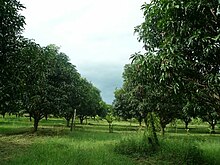Grove (nature)



A grove is a small group of trees with minimal or no undergrowth, such as a sequoia grove, or a small orchard planted for the cultivation of fruits or nuts. Other words for groups of trees include woodland, woodlot, thicket, and stand.
A grove is sometimes called "arbour" or "arbor", which is not to be confused with the garden structure pergola, which also sometimes goes under that name.
The main meaning of "grove" is a group of trees that grow close together, generally without many bushes or other plants underneath. It is an old word in the English language, with records of its use dating as far back as the late 9th century. The word's true origins are unknown; the word, or a related root, cannot be found in any other Germanic language.[1]
Naturally-occurring groves are typically small, perhaps a few acres at most. In contrast, orchards, which are normally intentional planting of trees, may be small or very large, like the apple orchards in Washington state, and orange groves in Florida.
Historically, groves were considered sacred in pagan, pre-Christian Germanic and Celtic cultures. Helen F. Leslie-Jacobsen argues that "we can assume that sacred groves actually existed due to repeated mentions in historiographical and ethnographical accounts. e.g. Tacitus, Germania."[2]
See also[edit]
- Brush arbour revival
- Bosquet is an artificial grove in a French formal garden
- List of giant sequoia groves
- The National Grove of State Trees at the United States National Arboretum
- Sacred grove
- Sacred trees and groves in Germanic paganism and mythology
References[edit]
- ^ "Grove, Oxford English Dictionary". www.oed.com. Retrieved 11 June 2020.
- ^ Helen F. Leslie Jacobsen, "The Sacred Grove in Scandinavian/Germanic Pre-Christian Religion", University of Bergen. Retrieved 29 June 2015
Further reading[edit]
- "Start Now to Design Citrus Groves for Mechanical Harvesting". University of Florida, Institute of Food and Agricultural Sciences. Retrieved 2006-01-06.
